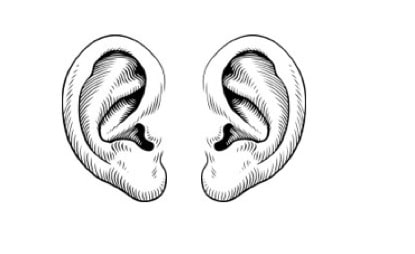 The phenomenon of binaural summation is considered one of the practical advantages of hearing with two ears.
The phenomenon of binaural summation is considered one of the practical advantages of hearing with two ears.
Binaural loudness summation (binaural additivity) has a long history of experimentation. This includes binaural loudness, comparisons between monaural and binaural thresholds, and comparisons of suprathreshold monaural and binaural loudness functions.
As early as 1929, von Békésy1 and Causse and Chavasse2, found maximum diotic summation from about 3 dB near threshold to approximately 6 dB with sensation levels (SLs) greater than 30 dB. Fletcher and Munson3 found that the maximum could be much higher – about 12 dB at 60 phons loudness. A rule of thumb might be expressed as:

The perception of loudness summation depends not only on the sound intensity, but also on the area size stimulated on the basilar membrane. Two sounds with different intensities and different bandwidth can be perceived as having the same loudness.
But, what about asymmectrical ears? Can they produce loudness summation? It has been demonstrated that binaural summation of speech in noise can occur even when the signal levels at the two ears differ as much as 25-30 dB4.
Certainly, monaural-binaural paradigm comparisons were essential in answering questions as to whether left- and right-ear simultaneous stimulation was summative relative to loudness. Early work cautioned that although the literature left little doubt that binaural summation of loudness existed, substantiation was still experimentally undecided5.
Today, it is recognized that binaural hearing is beneficial to loudness. It is well established that sound presented to both ears is perceived as being louder than the same signal presented to a single ear. This psychophysical effect is termed binaural loudness summation.
Loci
The auditory signals from the two ears are received at the cochlea and converted to electrical signals that are then sent to the cochlear nuclei. The nerve signals are combined in the superior olivary complex and then sent higher along the auditory pathway. Eventually, the brain utilizes information at the auditory cortices on both sides to form auditory percepts, of which loudness is one.
Is Loudness Summation Constant?
It appears that some variability exists depending on whether the signal is speech or tones, and whether presented via earphones or loudspeakers6.
Epstein and Florentine (2009) concluded that binaural summation from the loudspeaker was significantly less than binaural loudness summation in typical laboratory test conditions using earphones.
Loudness Summation and Hearing Aids
Ward7 produced evidence that binaural summed loudness would produce greater contraction of the middle ear muscles, and, as a result, would provide greater protection from high noise levels. Binaural exposure provided less TTS (temporary threshold shift) than monaural, with the greatest differences at the low frequencies. This would imply that hearing aids identified as “loud” may be more tolerable at slightly higher outputs than often thought.
Binaural summation is an advantage when fitting hearing aids because less gain is required in each ear to achieve the same loudness. With less gain, target gains are reached more easily, generally resulting in less opportunity for acoustic feedback. Consequently, most hearing aid prescription formulae automatically decrease gain by about 3 dB if the fitting is to be binaural. However, as shown in Figure 1, suprathreshold binaural summation is even greater than binaural summation at threshold, and hearing aids are fitted at suprathreshold, not threshold levels.
When loudness summation was compared between binaurally symmetrical high-frequency sensorineural hearing loss and normal hearing subjects, it was found that the hearing loss subjects compared favorably with normal listeners. As a result, it was suggested that binaural loudness summation may not be an important factor in selecting maximum output of hearing aids8.
References:
- von Békésy, G. (1929). Theorie des Horens. Phsik. Zeits., 30, 721-745 (see Bekesy, G. Experiments in Hearing Translation and Ed. E.G. Wever, N.Y.: McGraw-Hill, 1960, Fig. 7-19, p. 224
- Causse, R. and Chavasse, P. (1942). Differences between binaural hearing threshold and monaural threshold for perception of super threshold intensities (French) Society de Biologie et de les Filiales. p. 136
- Fletcher, H., and Munson, W.A. (1933). Loudness, its definition, measurement, and calculation. J. Acoust. Soc. Am., 5, 82-108
- Pollack, I. and Pickett, J.M. (1958). Stereophonic listening and speech intelligibility against voice babble. J. Acoust. Soc. Amer. 30, pp. 131-133
- Reynolds, G. S., and Stevens, S. S. (1960). Binaural summation of loudness, J. Acoust. Soc. Am. 32, 1337–1344
- Epstein, M. and Florentine, M. (2009). Binaural loudness summation for speech and tones presented via earphones and loudspeakers, Ear and Hearing, April, Vol. 30(2):234-237
- Ward, W.D. (1963). Auditory fatigue and masking. In J. Jerger (Ed.). Modern developments in audiology (pp. 240-286). New York: Academic Press
- Hawkins, D., Prosek, R., Walden, B., and Montgomery, A. (1987). Binaural loudness summation in the hearing impaired, J. Speech Hear. Res. (1987). March;30(1):37-43
 Wayne Staab, PhD, is an internationally recognized authority on hearing aids. His professional career has included University teaching, hearing clinic work, hearing aid company management and sales, and extensive work with engineering in developing and bringing new technology and products to the discipline of hearing. Dr. Staab is the Founding Editor of Wayne’s World and served as the Editor-In-Chief of HHTM from 2015 to 2017.
Wayne Staab, PhD, is an internationally recognized authority on hearing aids. His professional career has included University teaching, hearing clinic work, hearing aid company management and sales, and extensive work with engineering in developing and bringing new technology and products to the discipline of hearing. Dr. Staab is the Founding Editor of Wayne’s World and served as the Editor-In-Chief of HHTM from 2015 to 2017.







